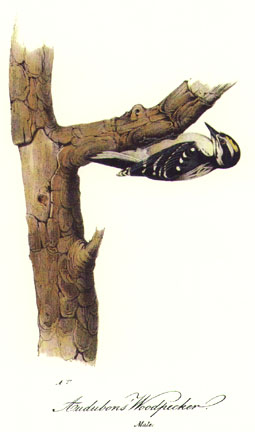

265 AUDUBON'S WOODPECKER
| My talented and amiable friend Dr. JAMES TRUDEAU, has described
this species in the seventh volume of the Journal of the Academy of
Natural Sciences of Philadelphia, where he says, "Hunting in a wood
fifteen miles from New Orleans, on the 26th of April, 1837, my attention
was attracted by a very extraordinary note, and after some difficulty I
succeeded in getting possession of the bird from which it proceeded. It
was very wild, running on the trunks and limbs of trees with the agility
peculiar to the family, always contriving to keep on the side of the
trunk most distant from its pursuer. It was the species here described.
I have frequently examined the spot in hopes of getting more; and
although I have often heard its note, the bird has, in the very thick
woods, eluded my pursuit. The sportsmen with whom I have spoken of it,
suppose it to be a common species. It is probable that this curious
bird, respecting which I have learned nothing farther, has escaped the
observation of naturalists on account of its resemblance to the two
species already named (the Hairy and Downy Woodpeckers)."
The specimen mentioned above was presented to me by its discoverer, my obligations to whom, on account of the honour which he has conferred upon me, I now gratefully acknowledge. My friend Mr. SWAINSON has also named after me a Woodpecker, procured in Louisiana, but which I believe to be only an immature specimen of Picus pubescens. PICUS AUDUBONI, Audubon's Woodpecker, Trudeau, Journ. Acad, Nat. Sc. Philadelphia, vol. vii. p. 404. AUDUBON's WOODPECKER, Picus Auduboni, Aud. Orn. Biog., vol. v. p. 194. Adult, 7, 13 1/2. Louisiana. Adult. Bill about the length of the head, strong, straight, differing from that of any other North American Woodpecker in having both outlines a little convex, and both tips acute. Upper mandible with the ridge very narrow, the sides sloping and flat, the lateral ridge near the margin, the edges direct, sharp, and overlapping; lower mandible with the angle rather long and narrow, the ridge very narrow, the sides convex, the edges sharp and inflected. Nostrils basal, oblong, near the edge, and concealed by the feathers. Head rather large, ovate; neck short; body rather full. Feet short; tarsus feathered anteriorly nearly half-way down, scutellate in the rest of its extent, and having a series of large scales internally behind; toes four; the first very short, the fourth longer than the third, which is united with the second at the base. Claws large, well curved, extremely compressed, laterally grooved, very acute. Plumage very soft, full, and blended. Wings rather long, the first quill only an inch and a twelfth in length, the second five-twelfths shorter than the third, which is one-twelfth shorter than the fourth, and an inch longer than the sixth. Tail of moderate length, cuneate, of twelve feathers, of which the outer is only eight-twelfths long, the next ten-twelfths shorter than the longest. Bill greyish-blue. Iris brown. Feet bluish-grey, claws brown. The upper parts are black; the tufts covering the nostrils white; on the anterior part of the top of the head are some feathers largely tipped with yellow, a band of white passes over the eye; the loral space and that behind the eye are black; a band of white passes from the angle of the mouth to the side of the occiput, and beneath it is a narrow band of black; the feathers along the middle of the back are tipped with white; the wings are spotted with white, some of the smaller coverts, the larger coverts, and all the quills being marked with that colour, of which there are six spots on the outer and four on the inner web of the longer primaries; the first primary has a slight spot at the base of the outer web, and two spots on the inner; the second has two spots on the outer, and three on the inner web; all the primaries except the two outer have a terminal white spot, the secondaries two, one on the outer, the other on the inner web. The four middle tail-feathers are black, the rest white toward the end, that colour enlarging so as to include almost the whole of the outer feathers. The lower parts are dull white, having a tinge of brown, the sides very faintly barred with dusky. Length to end of tail 7 inches; extent of wings 13 1/2; bill along the ridge (10 1/2)/12, along the edge of lower mandible 1; wing from flexure 4 1/4; tail 2 5/12; tarsus 9/12; hind toe 3/12, its claw (2 1/2)/12; second toe 5/12, its claw (4 1/2)/12; third toe 6/12, its claw (5 1/2)/12; fourth toe (6 3/4)/12, its claw 5/12. As Dr. TRUDEAU remarks, "this species resembles the Hairy and Downy Woodpeckers in plumage, but is very distinct, and is intermediate in size between them.
|